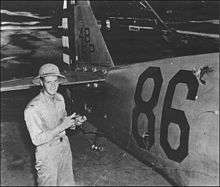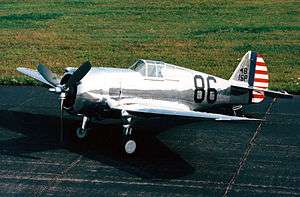Phil Rasmussen
| Philip M. Rasmussen | |
|---|---|
 Rasmussen beside damaged P-36 Hawk | |
| Born |
May 11, 1918 Boston, Massachusetts |
| Died |
April 30, 2005 (aged 86) Fort Myers, Florida |
| Buried at | Arlington National Cemetery |
| Allegiance |
|
| Service/branch |
|
| Years of service | 1940–1965 |
| Rank |
|
| Unit | 46th Pursuit Squadron |
| Battles/wars | |
| Awards |
Silver Star with one oak leaf cluster Distinguished Flying Cross Airman's Medal with three oak leaf clusters |
Philip M. Rasmussen (May 11, 1918 – April 30, 2005) was an Army Air Corps second lieutenant assigned to the 46th Pursuit Squadron at Wheeler Field on the island of Oahu during the Japanese attack on December 7, 1941. He was one of the few American pilots to get into the air that day.
Rasmussen was awarded a Silver Star for his actions. He flew many later combat missions, including a bombing mission over Japan that earned him an oak leaf cluster. He stayed in the military after the war and eventually retired from the United States Air Force as a lieutenant colonel in 1965. He died in 2005 of complications from cancer and is buried in Arlington National Cemetery.
Pearl Harbor attack
On the morning of December 7, Lt. Rasmussen had awakened in his barracks, when, looking out a window, he saw a group of Japanese airplanes dropping bombs on the field. He strapped his .45 caliber pistol to the outside of his pajamas and ran to get an airplane.
Most of the planes were destroyed, but Lt. Rasmussen found an unscathed P-36 Hawk and taxied it to a revetment where he had it loaded with ammunition. During a lull in the bombing, he took off with three other pilots. They received orders by radio to fly to Kaneohe Bay on the north-east side of the island.
The American pilots subsequently engaged 11 Japanese aircraft. Despite having a jammed .30 caliber gun and only limited capability with his .50 caliber gun, Lt. Rasmussen managed to shoot down a Mitsubishi A6M Zero. Several other Japanese pilots attacked, including one who apparently tried to ram him. (The Japanese pilot, Iyozo Fujita, returned to the aircraft carrier, Soryu, and survived the war.[1][2])
Rasmussen's plane was badly damaged and fell into an uncontrolled plunge into the clouds over the mountainous terrain. After passing through the clouds at about 5,000 feet he regained control of the aircraft and returned to Wheeler Field, where he landed with no brakes, rudder, or tailwheel.[3] Oral accounts of the number of bullet holes in the plane vary, but most give a figure of about 500.[4]
The opening exhibit of the World War II exhibit in the National Museum of the United States Air Force near Dayton, Ohio features a mannequin of a pajama-clad pilot climbing into a P-36 Hawk. The exhibit details Lt. Rasmussen's exploits that day and is informally titled "The Pajama Pilot."
Images
 In flight school
In flight school In New Guinea with P-400 Airacobra-Ia of 7th Fighter Command (Rasmussen on wing; others unidentified)
In New Guinea with P-400 Airacobra-Ia of 7th Fighter Command (Rasmussen on wing; others unidentified) Curtiss P-36A Hawk in the markings of the aircraft flown by Rasmussen during the Pearl Harbor attack
Curtiss P-36A Hawk in the markings of the aircraft flown by Rasmussen during the Pearl Harbor attack
Notes
- ↑ Rasmussen related this story at the 60th Anniversary Pearl Harbor reunion in Honolulu in 2001.
- ↑ Flight Journal, October 2002, David Aiken
- ↑ As recounted by Phil in "Myths of Pearl Harbor" documentary in 2004
- ↑ Personal recollection from Rasmussen is "over 500". Newspaper and other accounts range from 300 to 600.
External links
- National Museum of the United States Air Force - Fact sheet on Lt. Phillip (sic) Rasmussen and his P-36A.
- Aiken, David (Sep–Oct 2002). "Pearl Harbor's Lost P-36". Flight Journal Magazine. Retrieved 12/07/2010. Check date values in:
|access-date=(help) - Philip M. Rasmussen at Find A Grave